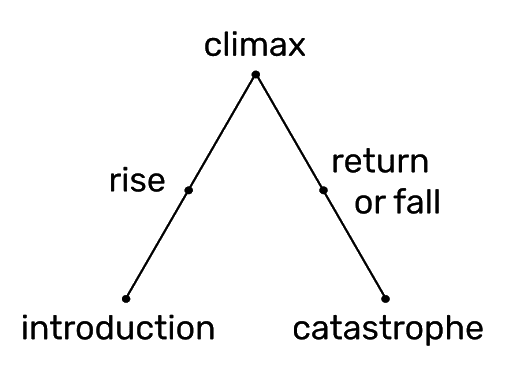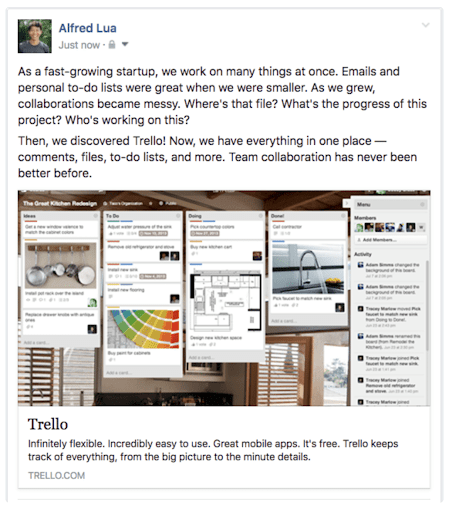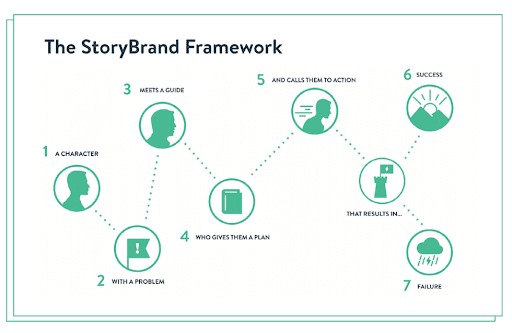People will forget pretty much everything about your brand, except how they feel about it.
Maya Angelou, perhaps, said it better about storytelling in general:

But what does it take to evoke the right feelings in your brand storytelling?
For us, good storytelling starts with structure.
In this post we’ll share a few fundamental story frameworks to guide your brand storytelling. They may not be familiar to you in name, but we’ll guarantee that you’ve come across them in countless novels, kids books, in movies, around the firepit in the summer, and—yes, in brand stories, too.
Let’s dive in, looking specifically at the story structures that are most applicable to brand storytelling and content.
1. Freytag’s Pyramid: Five-Act Structure
German author Gustav Freytag conducted a study of the dramatic structure of popular plays back in 1863, and came up with a model that’s stuck around. Freytag’s pyramid, as it’s come to be known, says that a story’s plot consists of five parts:
Exposition — where the story introduces important background information
Rising action — a series of events to build up to the climax
Climax — where the story gets turned around a bit (usually the most exciting bit)
Falling action — action continues from the climax towards the …
Dénouement — ah, ending the story with a resolution, catastrophe or revelation

You’ll see this framework used in countless brand videos. Check out this post from ClearVoice for an excellent breakdown of the use of the pyramid in Spring: The Charity Water Story (an amazing brand to learn from, in terms of humanized brand storytelling).
2. The 3-Act Structure
While you can use Freytag’s pyramid in short form, we see the three-act structure—kind of a short-form version of the 5-act dramatic structure—used much more widely in short content like social media posts. The 3-Act Structure consists of:
The Setup — Where you set the scene and introduce the character(s)
The Confrontation or “Rising action” — Presentation of a problem, or build-up of tension
The Resolution — Blissful resolution of the problem presented
You can see, for example, how brands like Buffer (shouting out Trello here) use the classic 3-act structure even in a simple Instagram post.

3. The StoryBrand Framework for Brand Storytelling
We love Donald Miller’s StoryBrand framework as a way to position the audience as hero in any story the brand chooses to tell. It’s deeply grounded in Joseph Campbell’s ‘hero’s journey’ narrative structure, and can help brands tremendously in crafting a memorable story arc and messaging which can then be applied to any kind of marketing, as well as website narrative flow.
The framework is deceptively simple, helping brands sketch out their audience (The Character) and their key pain point or problem, and how they might then come across the brand (The Guide), and how the brand might solve their problem (The Plan). It relies on a simple and clear Call to Action, and always spells out for The Character what success looks like—as well as what tragic outcomes might occur, should they choose the wrong (ahem, not your brand’s) solution.

You’ll find, again, countless examples of how brands use this structure to excellent effect in website storytelling.
4. The Pixar Story Framework
Emma Coates at Pixar came up with this story framework in a presentation she was giving about telling stories for Pixar. It’s now legendary. It can be used easily in founding stories, in explainer videos, and of course in Pixar movies. It is based on the following phrases.
Once upon a time there was ____________
Every day ____________
Then one day ____________
Because of that, ____________
And because of that, ____________
Until finally, ____________
We love this post from CauseVox about how to apply the Pixar framework to telling compelling stories about non-profit organizations to achieve instant understanding and emotional connection.
5. Features and Benefits Formula from Harry Dry
I stumbled across this framework in the amazing Harry Dry’s Marketing Examples newsletter — https://marketingexamples.com/subscribe — and have added to it, just slightly.
It’s a formula of sorts that can help you tell your brand features and benefits story quickly and easily.
It serves as a great entry point, with the addition of just one more question to help you tell richer, and more extraordinary brand stories.
Harry’s formula is as follows:
- Describe the feature.
- Ask: “so what?” to find the benefit.
- Contrast the old way with your new way.

I would add a fourth step, as follows:
- Consider who will use the feature, and exactly how. Get real details to humanize your story and to make it more inclusive. Then tell THAT story.
Pay attention to stories. Tell yours. It matters.
Need a helping hand to tell your story? Reach out—we’d love to chat.













